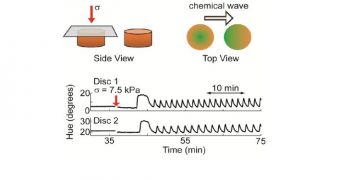With funds from the National Science Foundation and the US Army, researchers at the University of Pittsburgh and the Massachusetts Institute of Technology have recently tested a new type of gel. The material holds great promise for numerous applications, including robotic skins.
Coating future machines with this gel would literally enable them to feel touches, contact and so on, all through a chemomechanical approach. The non-oscillating gel can be resuscitated similarly to how medical cardiopulmonary resuscitation is conducted, the research team explains.
Details of the investigation were published in the March 26 online issue of the esteemed journal Advanced Functional Materials. The technology could be used in numerous applications, where devices need to sense mechanical stimuli, but respond chemically.
This phenomenon occurs naturally in living things that are covered in skin, but few artificial materials have thus far been able to replicate this trait. Piezoelectrics, for example – special crystals and ceramics – can produce an electrical current when they experience mechanical stress.
Researchers primarily focused their investigation on a material that was first developed in the late 1990s, called the Belousov-Zhabotinsky (BZ) gel. One of its most amazing features is that it pulsates in the absence of any type of external stimuli.
If conditions in its environment are just right, the gel will oftentimes resemble a beating heart, even if left alone in a petri dish. Some time ago, experts at Pitt argued that mechanical pressure could re-excite BZ gels that were not oscillating.
Researchers at MIT were recently able to demonstrate that compressing the BZ gel beyond a certain threshold can indeed have the predicted effect. The idea was first proposed by scientist Anna Balazs.
She holds an appointment as a distinguished professor of chemical and petroleum engineering at the Pitt Swanson School of Engineering. A video showing the unique behavior of BZ gels can be seen here.
“Think of it like human skin, which can provide signals to the brain that something on the body is deformed or hurt. This gel has numerous far-reaching applications, such as artificial skin that could be sensory – a holy grail in robotics,” Balazs explains.

 14 DAY TRIAL //
14 DAY TRIAL //